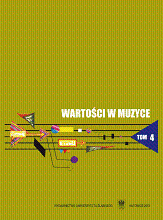
Muzyka w środowisku szkolnym dziecka
The author analyses factors determining learner’s musical development in the school environment. She underlines the role of learner’s emotional attitude to the subject contents being covered, gaining musical abilities indispensable to shaping personal culture. She perceives a teacher as a guide familiarizing learners with the secrets of musical language, and claims that both teachers and learners must be creative and responsible to one another in the process of music education. An efficient realization of pedagogic values of music can make music accompany them also in adulthood.
More...